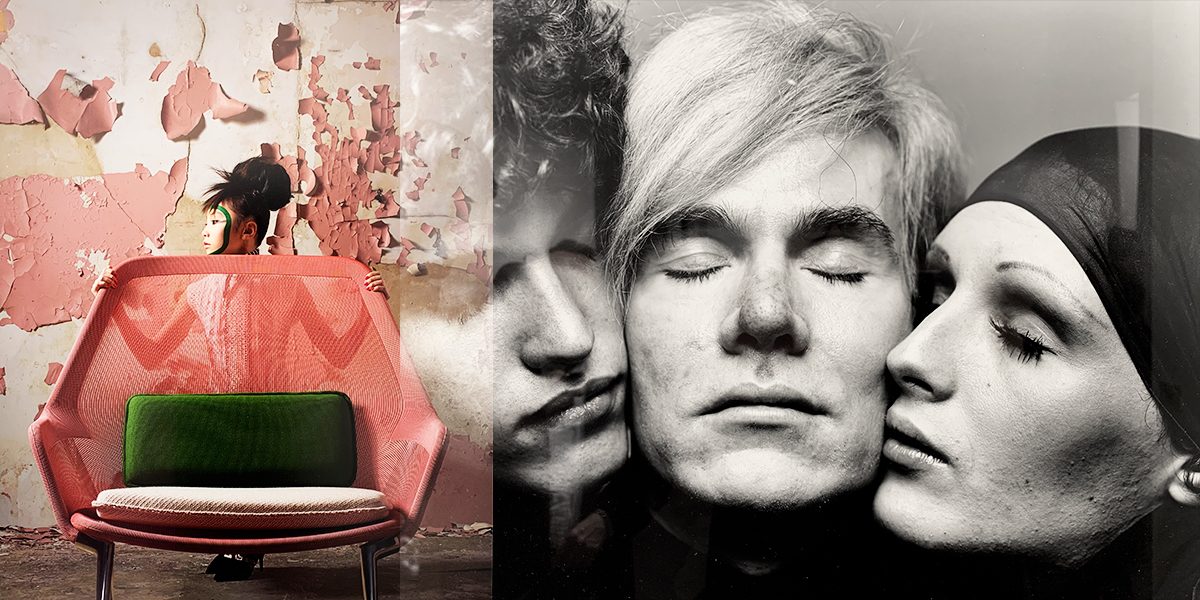ParisPhoto, the biggest photo fair in Europe held each November at the Grand Palais, returned with its 22nd edition, attracting nearly 70.000 visitors in four days and gathering more than 200 exhibitors from all around the world, offering an unparalleled presentation of contemporary and vintage photography from grandmasters to emerging young talents.
“There are images not everyone would like to see” Martha Kirszenbaum (curator)
ParisPhoto is much more than just an art fair. It’s an emotional journey. Throughout the city, many satellite exhibition openings, book signings and art events seduced the visitors. ParisPhoto is also a melting pot, a unique gathering of friends and professionals meeting up and getting skin close to artists. At Pace/MacGill Gallery I encountered Paolo Roversi during his book signing, at Frank Elbaz Gallery the artist Ari Marcopoulos and viewed his exhibition with co-host Thibaut Wychowanok of Numéro Art, and at Polka Gallery I had a passionate conversation with writer and former film critic of Libération, Gérard Lefort during the “Inside Outside” exhibition and book signing of New York-based photographer Joel Meyerowitz.
Other evenings have taken me to Sotheby’s, Jeu de Paume and fringe events at Offprint, Photo Saint Germain and Approche.
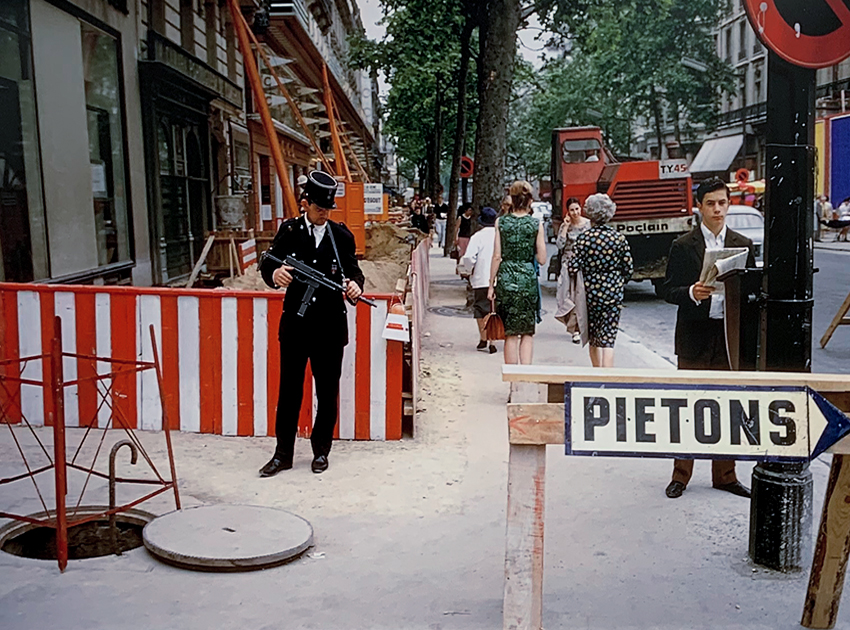
“Paris” by Joel Meyerowitz – Polka Gallery / Photo © Courtesy of ZOLTAN+
When ParisPhoto is more than just an art fair. It is political.
I am sure it was not deliberate that 11.11, the centenary of the Armistice of World War I happened at the same time as ParisPhoto. While the Grammy Award-winning Beninese actress, activist Angelique Kidjo sang the heartbreaking Togolese song “Blewu” to the world leaders who gathered to mark the event at L’Arc de Triomphe, ParisPhoto echoed a very simple question: “Shouldn’t we be living differently by now?”
People make signs. The art world makes signs (see the latest action of Gavin Turk in London), but the voices are still not heard in many governments, in many countries. You know exactly the ones I mean. Peace has definitely not impregnated our lives. Nationalism is a betrayal. Gun violence is not OK. Global environmental issues and climate changes are running into a disaster. Wars, violence, anti-Semitism, women’s rights, black rights, famine, food waste or the dysfunctional Brexit … indeed how many times do we have to blow the whistle to get some attention?!?
Artlyst looked for the answers and listed the most significant artists and galleries of this year’s edition of ParisPhoto.

Video shot of “Momentum” and cover of TIME magazine by JR / Photo © Courtesy of ZOLTAN+
MAISON EUROPÉENNE DE LA PHOTOGRAPHIE
The “In Paris during ParisPhoto” programme reunited a dense network of cultural institutions, museums and private foundations throughout the city comprising some of the world’s most historically rich photographic collections. At the Maison Européenne de la Photographie, artist JR opened his monumental photographic exhibition “Momentum”. During the press opening, he was hiding behind his dark glasses and hat inside a wooden niche installation answering the press through a pipe.
“Momentum” is JR’s first major exhibition on French institution territory bringing large-scale collages, video, live performance and several new installations together. In one of the rooms, he glued the eyes of a woman on a running train. He also made the pyramid of the Louvre disappear, stuck thousands of anonymous people’s portraits in public spaces and on the walls of a favela in Rio de Janeiro, he made a little Mexican child looked over the border wall of the United States, and sometimes he wildly motorcycles with French film director icon Agnès Varda. With Massimo Bottura he recently launched an haute cuisine soup-kitchen in the crypt of La Madeleine church in Paris. The list is endless.
12 years after his exhibition “Portrait of a Generation” JR’s latest exhibition at the MEP gathers his projects from graffiti, collages to his illegally displayed giant, black & white portraits, made with a 28mm lens, giving voice to anonymous people. “Momentum”, the mechanics of the event, also unveils an interactive fresco exploring the impossible and devastating gun control in the US. Throughout hundreds of tiny video images, JR created a giant wall of individual video-portraits, used also for the triple-page cover of TIME magazine.
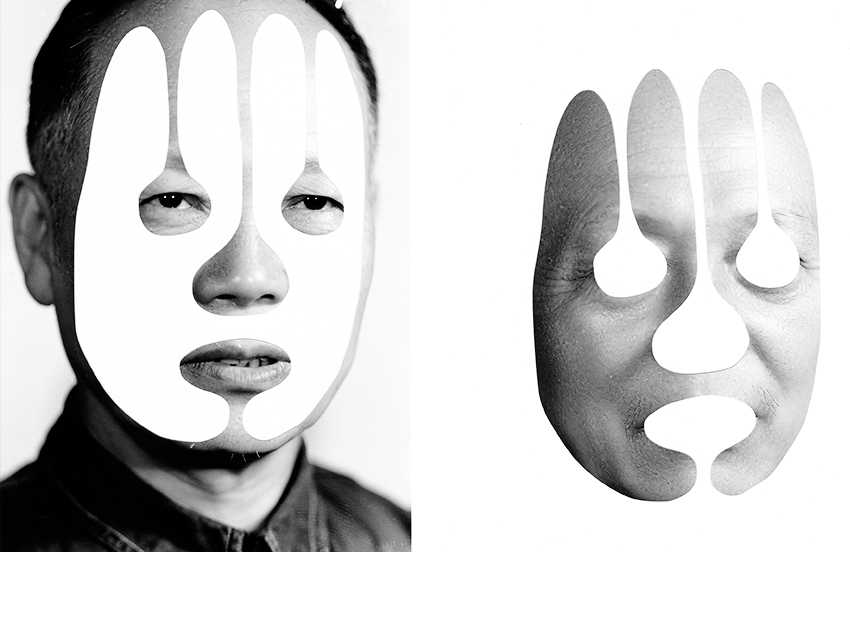
“No More, No Less” by Kensuke Koike & Thomas Sauvin / Photo © Courtesy of Accroche Production
A PPR OC HE
Near Palais Royal, in a private mansion on rue de Richelieu, co-founder Emilia Genuardi and Elsa Janssen welcomed visitors with the second edition of A PPR OC HE, a salon devoted to experimental photography practices, the desire to bring artists from visual arts and photography together who do not use traditional photographic media.
First, they have fallen in love with the works, the artists, the personalities, then asked the galleries for a participation to end up with a strongly curated project. Each artist had a metaphorical room, intimate and private, as opposed to impersonal, commercial fairs. They gathered 15 artists represented by 12 international galleries including the A PPR OC HE sector, highlighting Kensuke Koike and Thomas Sauvin.
Thomas Sauvin from Paris and Beijing and Kensuke Koike, based in Venice, presented a breathtakingly beautiful series of silver prints “No More, No Less” combining collage and found photography made from original negatives.
The resulting prints were subjected to the sharp imagination of Koike who used only a blade and adhesive tape to deconstruct and reinvent the images. This purely manual intervention had one strict rule: nothing to be removed; nothing to be added, simply “No more, no less”.
It was a perfect collaboration between the two; Sauvin who is both artist and collector, owning more than half a million negatives collected and grouped together under the title “Beijing Silvermine”, and Japanese artist Kensuke Koike who is renowned for his collages. After having bought vintage photos in an antique shop in Milan, Koike now owns more than 20,000 photos and postcards that he cuts, using scissors, scalpels and pasta machines, transforming them into magical dreams.
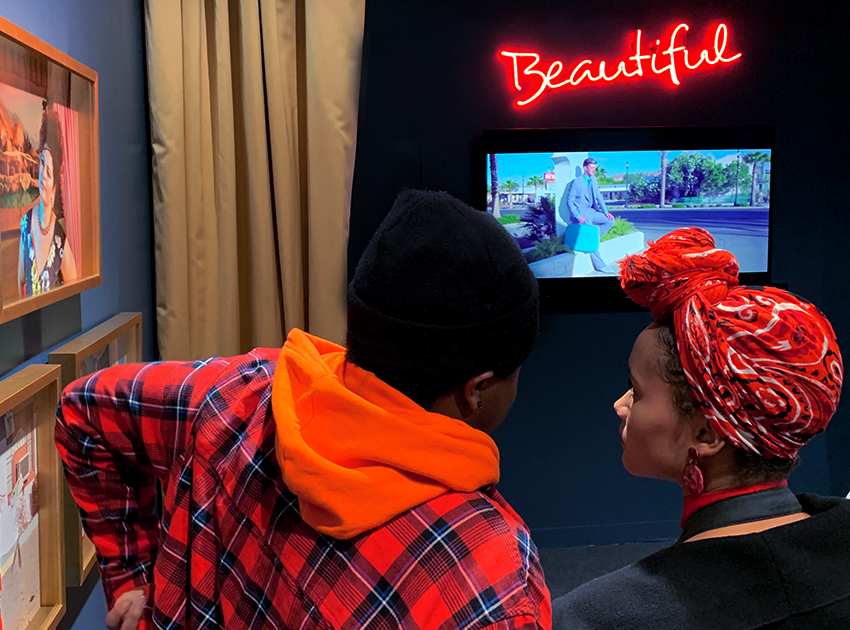
Visitors at Kourtney Roy installation at Pernod Ricard / Photo © Courtesy of ZOLTAN+
PARISPHOTO
It has taken 22 years, ParisPhoto is finally back celebrating women photographers. The Fair’s director Florence Bourgeois and artistic director Christoph Wiesner insisted that this year, galleries should highlight their female artists more than ever before.
The project Elle x ParisPhoto was headed by Fannie Escoulen and supported by the French Ministère de la Culture. Brigitte Macron, France’s First Lady and Franck Riester, the French Minister of Culture showed great interest during their visit.
ParisPhoto is an art fair embracing many different sectors and subjects. In the aisles of the main and largest section, galleries, beyond gender issues, landscapes, still lives, fashion and abstract works, were showcasing rare and historic work, solo and group shows, focusing on cutting-edge photographers working with image-based art and more and more on work by female photographers.
On the first floor, the prestigious Salon d’Honneur housed private collections including the McEvoy Family Collection and the JP Morgan Chase Art Collection, also PRISMS, showcasing large-format series and installations exploring the diverse forms of photography.
The Book section, brought publishers, book dealers and several hundred book-signing events together, also some special book presentations under the arches including Steidl and Louis Vuitton Edition.
The Film sector, in the MK2 Grand Palais cinema, highlighted the relationship between still and moving image selected by Pascale Cassagnau of Centre National des Arts Plastiques CNAP and Matthieu Orléan of Cinémathèque Française.
The Public Programme’s core aspect provided visitors with insights to the waste world of art. The programmes included exhibitions with the Fair’s official partners BMW and JP Morgan, the Platform cycle of talks with curators and artists, the ParisPhoto Aperture Foundation PhotoBook Awards, the Carte Blanche-Students section and many special events exploring emerging trends.
The new section Curiosa, exclusively devoted to erotic photography, fetishism, relations of power, domination and gender issues from hardcore shots to Japanese bondage, brought intimate images together by 14 artists including Nobuyoshi Araki, JoAnn Callis, Antoine d’Agata and Edouard Taufenbach, curated by independent curator and writer Martha Kirszenbaum,
“The Japanese invented bondage.” says Kirszenbaum, “They took the ropes from passing ships. At Curiosa, there are images not everyone would like to see.”
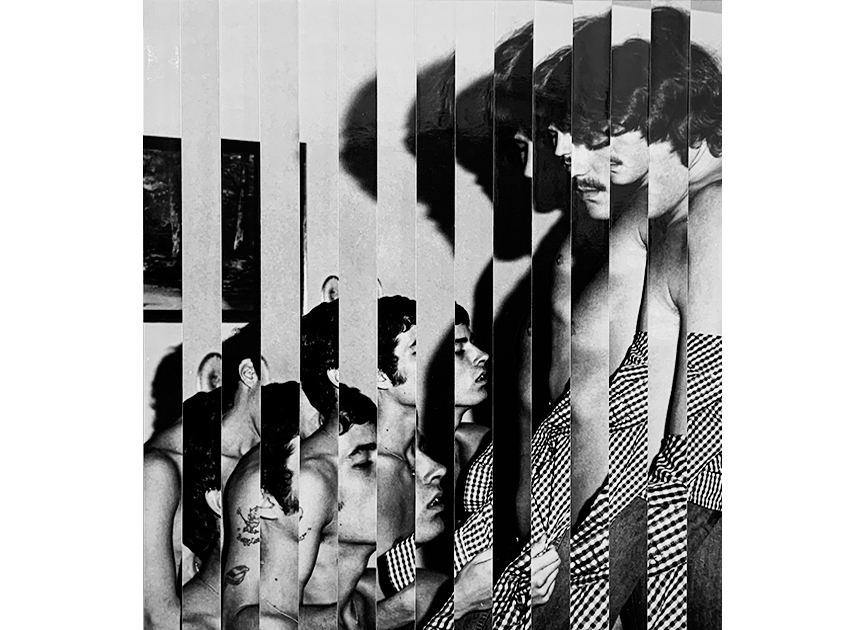
“Spéculaire” by Edouard Taufenbach / Photo © Courtesy of ZOLTAN+
CURIOSA
Edouard Taufenbach’s stunning, erotic photographs “Spéculaire” were presented by Galerie Binome at the gallery’s main stand and also at Curiosa.
“I became fascinated with editing while studying cinema at the Sorbonne, however, after graduation, I did not choose to direct. I used to edit videos then turned to photography, collage, using anonymous family photographs found at various places. For my current series, I collaborated with French film director Sébastien Lifshitz of “Les Invisibles”, winner of César 2013, who had already a great collection of personal and intimate photos and was intrigued by homo-erotic and gender issues.”
“We looked through hundreds of images without knowing from where they were coming from. The original images were very suggestive, sometimes hard-core, erotic, but the way I have reassembled them made them indirect. These artworks often question the boundaries of memory and fiction. I injected cinema, time and rhythm into my images.”
In “Spéculaire” Taufenbach pushed his photographic work into fluid memories, with a slight reference to Pierre Molinier, in-between a moving image and still photography cutting the photos into small pieces and meticulously reassembling them. When I look at his images it is like looking at an entire movie in a single frame. “In fact” – he adds – “all my life is about cutting and collaging”.
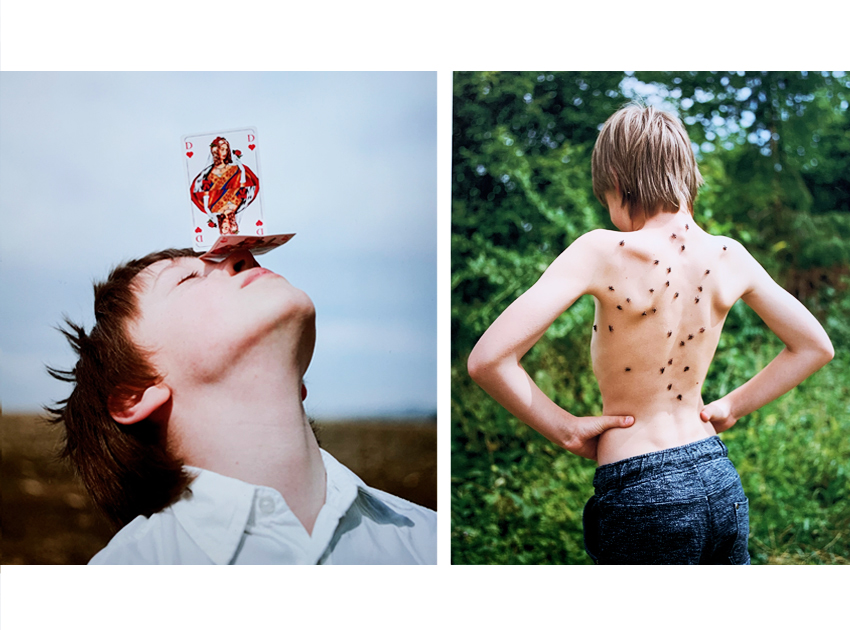
“How far is a light year?” by Simon Lehner / Photo © Courtesy of ZOLTAN+
CARTE BLANCHE
ParisPhoto, Picto Foundation and SNCMacgillF Gares & Connexions partnered to launch a platform for the discovery and exposure of outstanding young talents.
For the second executive year, Carte Blanche presented four students, currently enrolled in photography and visual arts at various European master and bachelor university programmes and displayed their work simultaneously at the Grand Palais and the Gare du Nord railway station.
This year’s winners were: Daniel Szalai (Budapest), Kata Geibl (Budapest), Dara Minina (Paris) and Simon Carlier Lehner (Vienna). In addition, their images were projected and celebrated at the newly reopened and redesigned, ultra-chic Les Bains.
CARTE BLANCHE / SIMON LEHNER
22-year-old Lecher from Vienna was not only one of the finalists of Carte Blanche but also the winner of the Maison Ruinart Award 2018. Following his hunters and war zone series, he presented his therapeutic project “How far is a light year?” based on his family, since his father left them in 2005. In this series, he wanted to recreate the ideal father figure, the way he always wanted to imagine his father. The images are based on tension, jealousy, and a summer holiday he spent with him.
Lehner mixed his archive family pictures with computer-generated images of his imaginary farther to explore the life of an Ai artist.
His calm and painful images were rewarded by the Maison Ruinart Prize. “We are already present at Frieze London, ParisPhoto and many international art fairs and art events.” – states Marie-Charlotte Wambergue of Ruinart during my interview. “We have been for some time thinking to give a philanthropic voice to the young generation and we are very proud to participate with Carte Blanche for the first time.”
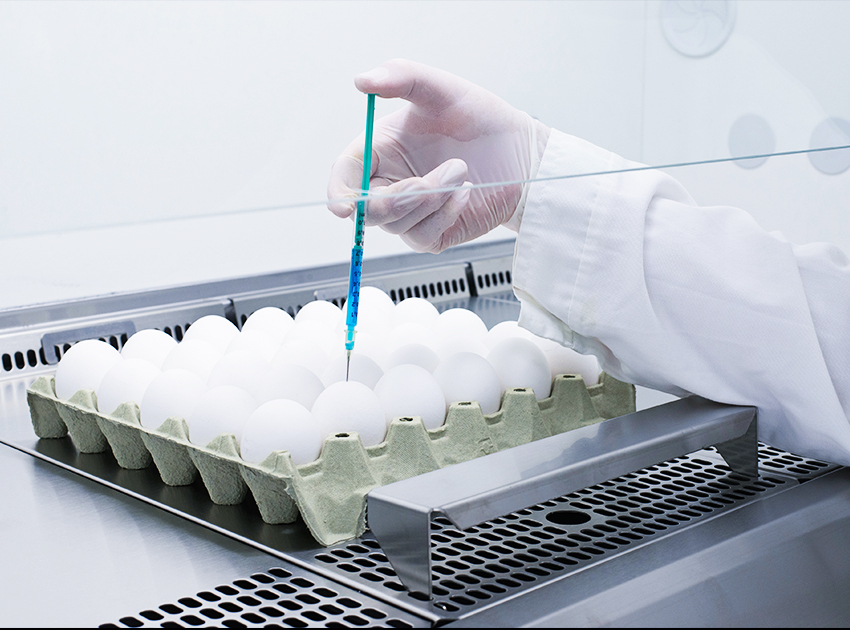
“Novogen-Injection” by artist / Photo © Courtesy of Daniel Szalai
CARTE BLANCHE / DANIEL SZALAI
Another finalist from Budapest, Daniel Szalai, presented a first very humorous series of chicken heads, 168 portraits of individual portraits of chicken, turned out to be a very disturbing and serious project.
His series “Novogen” documented the insight production of the industrialized chicken farming and the egg industry to produce a special breed of chicken, free of all diseases, kept under strictly controlled sterile conditions whose eggs are used in the production of pharmaceutical products, medicines and vaccines. These entirely man-manipulated creatures are the product and the development of biochemistry and of agricultural technology.
The company in Hungary, which gave the artist the permission to take his pictures, specializes in the large-scale production of eggs for the vaccine industry and is the largest producer in the whole of Europe, with the production of 120,000 embryo eggs per week.
The pragmatic way we think about these creatures reflects a general attitude towards our environment and it resonates in our relationship to nature.
“Although that technology is now an inseparable part of us, and these chickens are kept in reasonably good conditions, it is somewhat shocking and disturbing to see the industrialized life of Novogen chickens, knowing that their only task is to produce the final product, the eggs before their lives get terminated.”

“Video frame: Oil and Water” by Deborah Oropallo / Photo © Courtesy of ZOLTAN+
CATHARINE CLARK GALLERY
During ParisPhoto, while many photographers chose traditional flat prints, others departed to find new forms of expression, incorporating techniques such as cutting, painting, weaving, layering, montaging, sculpturing.
Having spent 28 years in contemporary art, Catharine Clark Gallery from San Francisco returned for the third executive year to ParisPhoto with new works by Deborah Oropallo, Edgar Martins and Stephanie Syjuco. The gallery is well-known for its refined editing and installations. Founder Catharine Clark with gallery art director Anton Stuebner created a perfect conversation between the exhibited artists and their works.
I toured around their booth with San Franciscan collector and founder of the Minnesota Street Project, Deborah Rappaport.
“What jumps out first is the cohesive and beautifully edited booth with great continuity and carefully selected artists, who were visibly largely driven by issues such as social justice, environment and politics.”
Catharine Clark joins in and walks us to Deborah Oropallo’s wall. “She mostly thinks of herself and her process as a painter, but in this case, Oropallo created some extraordinary multi-faceted montages and a video installation. Even the content is a montage, throughout extraction and shifting images found on the Internet with particular news items on ecology, flooding, refugee crises and other major issues. Her series reflects on our cultural habituation to political and ecological traumas.”
“Here, for instance, in “Video Frame: Deluge” she did not want to just look at one particular flooding, she found many images of water from Bangladesh to Texas, relevant to global events, to global problems. On other photographs, she worked with images of oil spills, wildfire, melting ice and took them further than just creating a traumatic image. Deborah believes in “Slow Art” as we consume and dismiss important images so rapidly.”
Catharine Clark Gallery put the emphasis on the ethical responsibility of photographs at the intersection of their other two artists, Stephanie Syjuco and Edgar Martins. There was a strong, visual conversation between the two; the haunting image of Syjuco “Total Transparency Filter (Portrait of N)”, a covered woman, visible, but not recognizable, and Martins’s “What Photography has in an Empty Vase”.
While Syjuco is absorbing, processing the world around her, which becomes more and more political, Martins explores the philosophical concept of absence. From a humanist point of view, his work reflects on the absence of a loved one brought on by enforced separation.
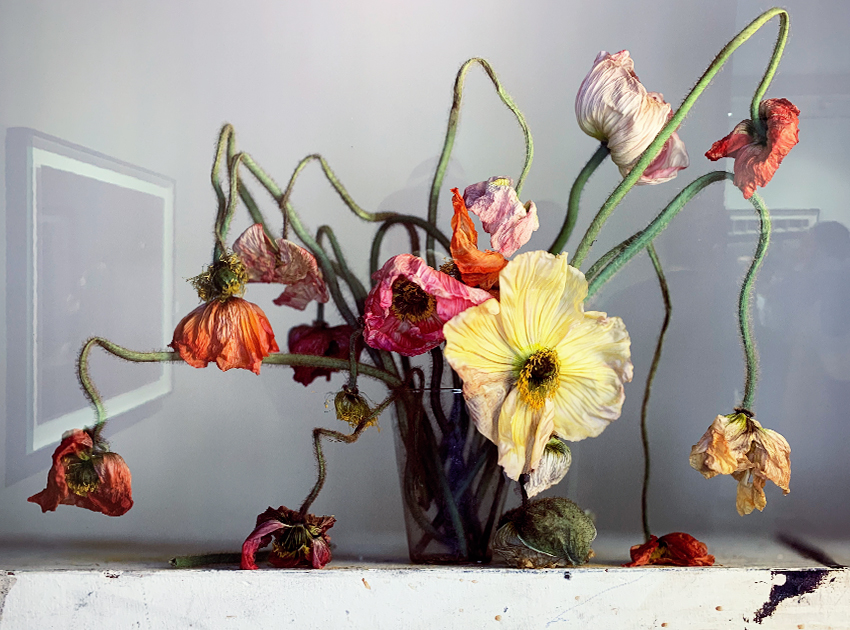
“Live & Dead Poppies” by Richard Learoyd / Photo © Courtesy of ZOLTAN+ and Pace/MacGill Gallery, New York
PACE / MACGILL GALLERY
British artist Richard Learoyd embraced the beauty and photographed stunning live and dead poppies with a homemade camera obscura. A simple message to remember.
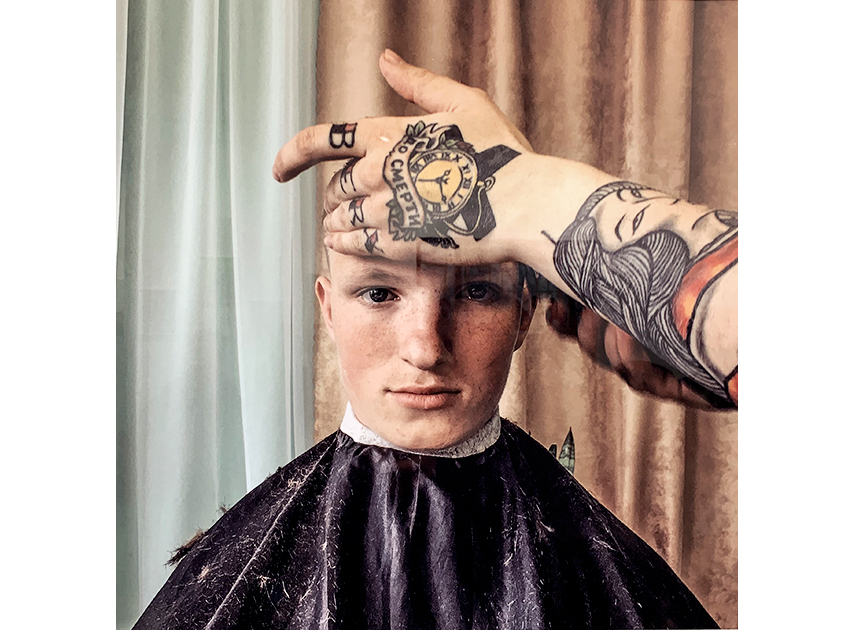
“Craft” by Dmitry Markov / Photo © Courtesy of ZOLTAN+
GALERIE DU JOUR / AGNÈS B.
Russian photographer Dmitry Markov is wild at heart, disturbing by his images. After his camera was stolen at an orphanage, where he was volunteering, his mobile phone came very handy. He started using an iPhone as opposed to heavy cameras, to give visibility to social issues, people and the devastating daily life in small towns in today’s Russia. “Quality? Screw it, I’d sketch with a pencil if I could draw” he said it in one of his online posts. Markov is now permanently relocated to Pskov, where the orphanage is, close to the Estonia border, and has more than 200.000 followers on Instagram.
Markov began as a journalist but transitioned into photography to show visually what was impossible to describe in writing. He started working with orphans as a tutor and focused on the social problems of his home country. His photos are an honest testament of hard and often cruel life, a mixture of poor, disillusioned people, alcoholics, drug addicts, factory workers, prostitutes, women, sad and happy children. His lens gives an unflinchingly real depiction of life.

“The Existence of the Other as a Threat to my life” and “That Work of Death” by Ayana V Jackson / Photo © Courtesy of ZOLTAN+
BAUDOIN LEBON GALLERY
The well-established Parisian gallery, directed by sharp-eye Baudoin Lebon from Carreau du Temple, presented Gérard Rondeau for ParisPhoto and brought the acclaimed photographer Ayana V Jackson from their represented artists. The gallery also published a beautiful book on her work “Archival Impulse & Poverty Pornography “.
Jackson needs no introduction. She commutes between Johannesburg, Paris and New York. Her work examines the role of photography in the construction of identity, using performance and studio portraits. Her practice is interpreted as a relationship between a photographer, subject and viewer.
With a particular interest in the representation of black bodies during the 19th and early 20th Centuries, Jackson questions the role and the history of photography in the construction of racial stereotypes.
In her series a woman dodging the Bullets of Justice, until she succumbs to the criminal justice system in the end.
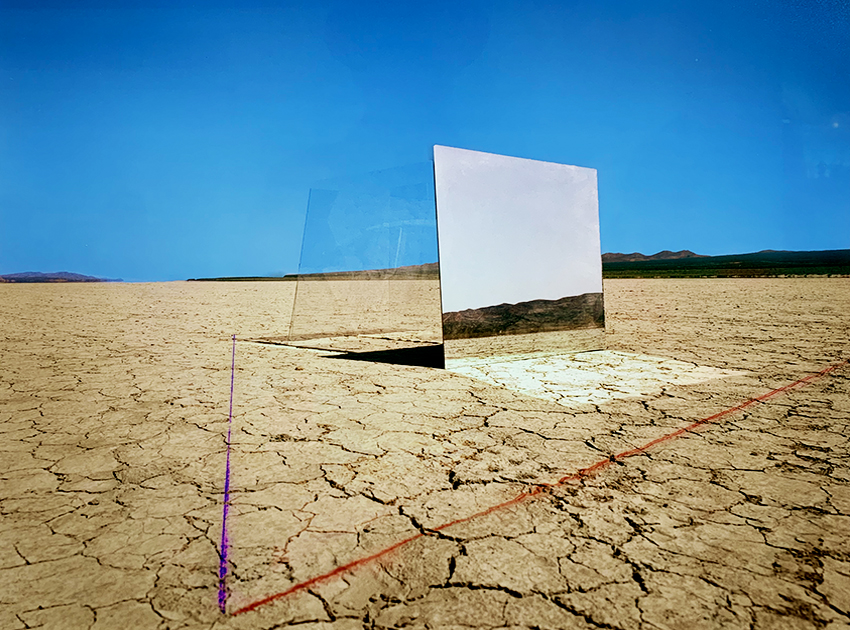
“El Mirage” by Grey Crawford / Photo © Courtesy of ZOLTAN+
TAIK PERSONS GALLERY
Founded in Helsinki, the Berlin-based gallery Taik Persons exhibited “El Mirage”, the work of Grey Crawford from Southern California.
Looking at his visual landscapes Crawford has chosen elements that add up to a visual harmony of shapes, creating a visual syntax to examine our times. “I see myself as a visual bilingual, in Abstract and Image, combining the language of painting and photography leaving the territory of clear distinctions.”
Southern California in the early 70s was an island of its own creation. A mixture of surf, sea, sun and highways winding around the ever-changing cultural climate. Claremont, a small town at the eastern side of LA, has been a mecca for artists of all disciplines since the 1920s. Crawford had a rich introduction to abstract paintings, was exposed to various shapes and forms and absorbed them into his subconscious.
Crawford’s early black & white photographs combine construction and zen-like capacity for reduction. He stood out at an early age as a unique figure with his experiments with paper masks, cut specific to each image and shape. These masks were used to allow separate exposures in the areas he selected, going from white, through grey tones to solid black. Crawford incorporated these geometric shapes and lines into his photography, creating his own landscapes, like a stage for an undefined play.
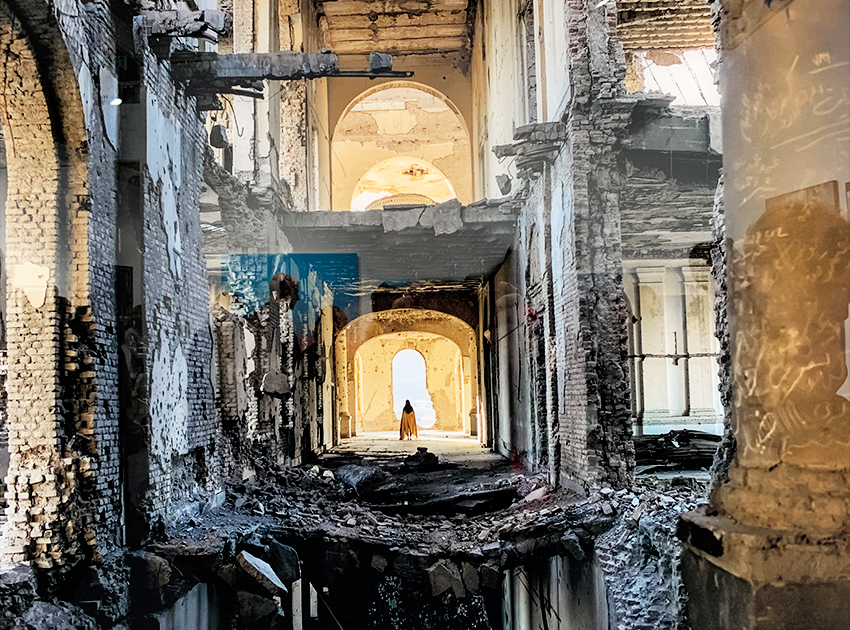
“Past Continuous” by Tahmineh Monzavi / Photo © Courtesy of ZOLTAN+
SILK ROAD GALLERY
From Tehran, Iran, the gallery Silk Road presented female photographer Tahmineh Monzavi. Her core topics are often social conflicts and the young generation of Iran. She has also put together a controversial project on Transsexuals, addressing how a minority group of people can exist within the traditional Iranian society; how to seek social acceptance and recognition. Monzavi’s vision was reinforced after a month of being imprisoned; she started looking at her society differently.
The artist is also known for her lengthy projects, trying to work in long intervals, as her current work, a photo series of the young generation and women in various Iranian cities.
She also witnessed many agonising and devastating demolitions of glorious buildings and their poor replacements of soulless hi-rise residences. The broken bricks, crumbling walls and ruins could have been her childhood home.

“Rosa” by Nathalie Boutté / Photo © Courtesy of ZOLTAN+
YOSSI MILO GALLERY
Nathalie Boutté cuts paper into strips, sculpting all types of paper: maps, novels, printed paper, tracing paper, banknotes, and offers a second chance to materials that had its own function in a previous life.
“I never gave up the contact with paper. It is, by far, the raw material I prefer to work with today.”
Boutté’s creations are not simple compositions, she creates three-dimensional collages; the small paper stripes are superimposed and glued one by one, row by row. Closely, the texture of the paper is omnipresent as the distance to the work removes the material in favour of a pictorial embodiment, and magical editing of unparalleled attention to detail.

(left) “The One” and (right) “Infinite” by Delphine Diallo / Photo © Courtesy of ZOLTAN+
FISH EYE
It is hard to find a more charming, dedicated and activist artist than New York-based French-Senegalese photographer Delphine Diallo. Her earlier work has been highly influenced by acclaimed photographer Peter Beard with whom she spent 6 months. After viewing the images she had made in Senegal, Beard saw great potential in her work.
Diallo’s work always starts with painstaking research, juxtaposing reality with imaginary consciousness, using documentary and tradition with a strong contemporary style. It is a transformation, a metamorphosis, birth, rebirth, death. Her studio is a ritual; in fact, in Diallo’s life, everything is a ritual. She is full of energy, like “water”, she never stops. Her direction and vocations are well-grounded. She creates portraits of women of colour, fearless, iconic women, a bit like herself. I wonder sometimes, if anyone has ever said no to her in her life.
In New York, Diallo takes part in the unground scene, collaborates with many other fellow artists and enjoys working with friends, as “friendship is a gift, a neutral trust” she says, with great conviction.
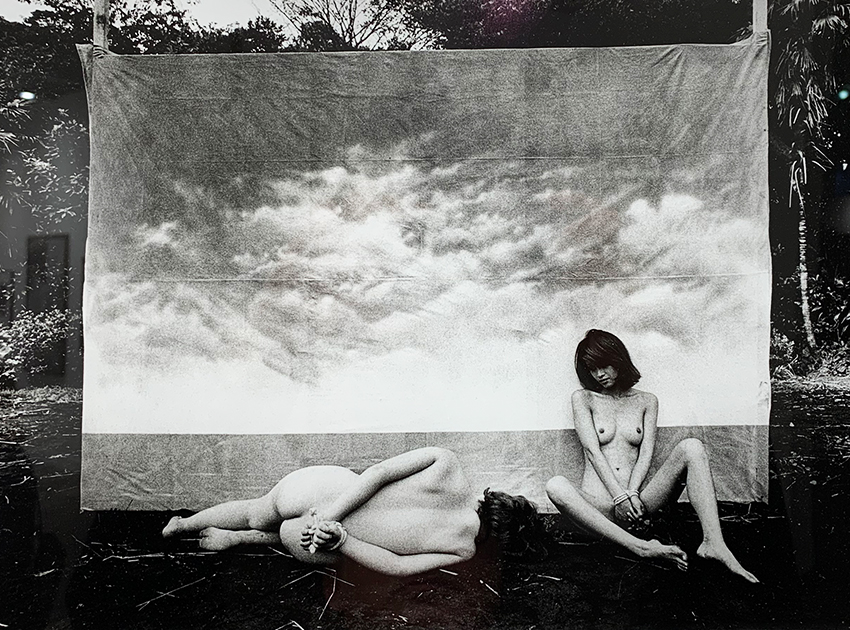
“Kagerou (Mayfly)” by Daido Moriyama / Photo © Courtesy of ZOLTAN+
AKIO NAGASAWA GALLERY
The Tokyo based gallery Akio Nagasawa presented Daido Moriyama, one of the most celebrated photographers to emerge from the Japanese Provoke movement of the 1960s, noted for his pictures depicting the breakdown of traditional values in post-war Japan. He is also known for his rejection of technical precision in favour of grainy and high-contrast images produced by his pocket camera.
“I always felt that the world is an erotic place. For me, cities are enormous bodies of people’s desires and I search for my own desires within them.”
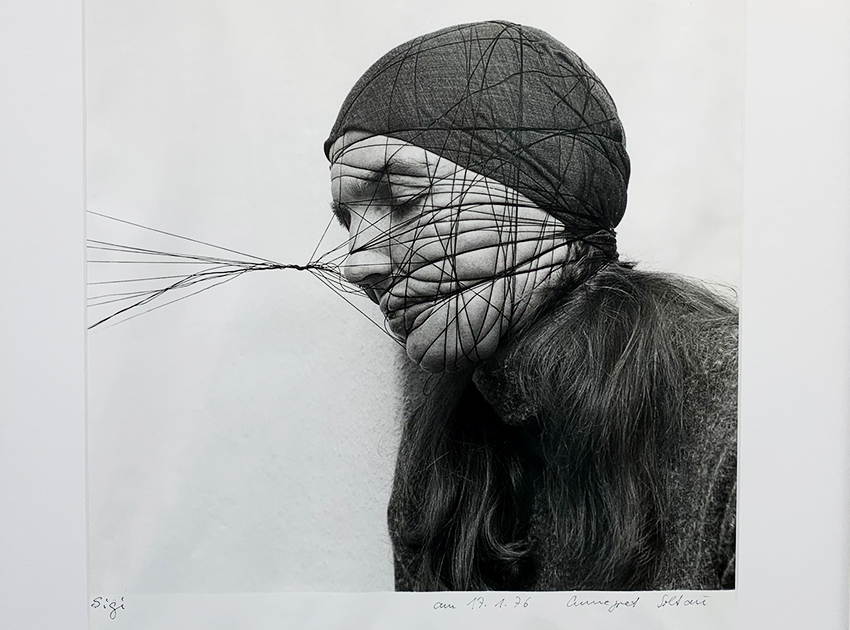
“Permanente Demonstration (female)” by Annegret Soltau / Photo © Courtesy of ZOLTAN+
ANITA BECKERS GALLERY
Annegret Soltau‘s work has been considered fundamental for the development of the experimental and feminist art of the 70s and 80s. Her work not long ago was included in “Feminist Revolution”, the first comprehensive, historical exhibition to examine the international foundations and legacy of feminist art, organized by Moca in LA, and presented also at MoMA PS1 in New York.
Soltau’s main interest is in the integration of body processes in her work, in order to connect body and spirit and treat them as equal components. Always departing from a private performance or photographs of herself, she creates photomontages of her body and face sewn over or collaged with black thread.
In “Permanente Demonstration” it is more like a process to re-unite consciousness and unconsciousness. Soltau aims to work intuitively. She is interested in immediately perceptible experiences as she feels that as soon as we reflect and form a concept, the original is lost.
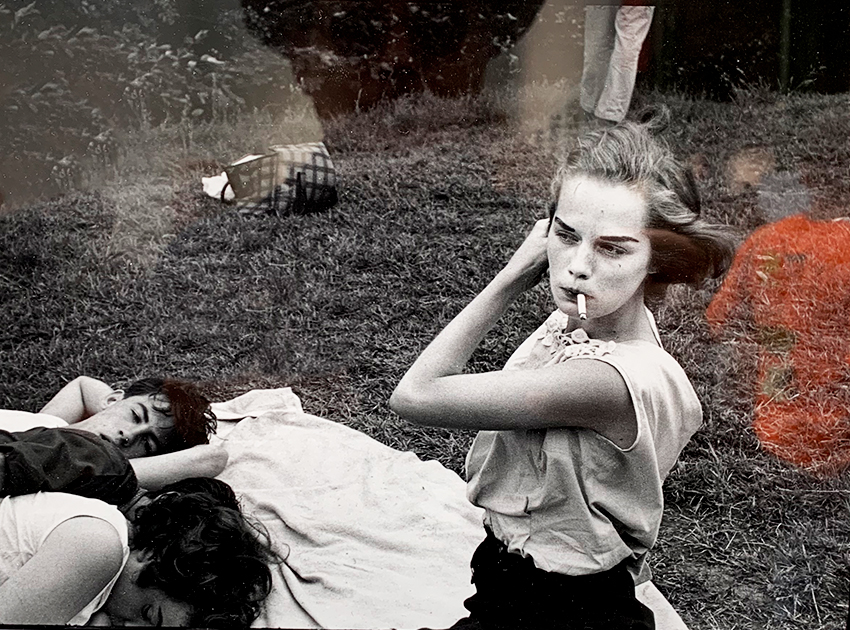
“Brooklyn Gang” by Bruce Davidson / Photo © Courtesy of ZOLTAN+
HOWARD GREENBERG GALLERY
The New York-based gallery presented 71 classic images by documentary photographer Bruce Davidson. He set out during the summer of 1959, at age of 25 to capture a teenage street gang in Brooklyn and followed them from soda shops to late night dancing. Davidson recorded the first fully immersive photo essay of American youth subculture.PARISPHOTO / Grand Palais, Paris / 8 – 11 November 2018
TOP COVER PHOTO: (left) “Shanghai” series by Erwin Olaf – Galerie Magda Danysz, (right) “Andy Warhol and Jay Johnson with Candy Darling” by Richard Avedon – Gagosian Gallery / Photo-montage © Courtesy of ZOLTAN+
Text, interviews and photos by courtesy of Zoltan Alexander © ZOLTAN+ London © ArtLyst

